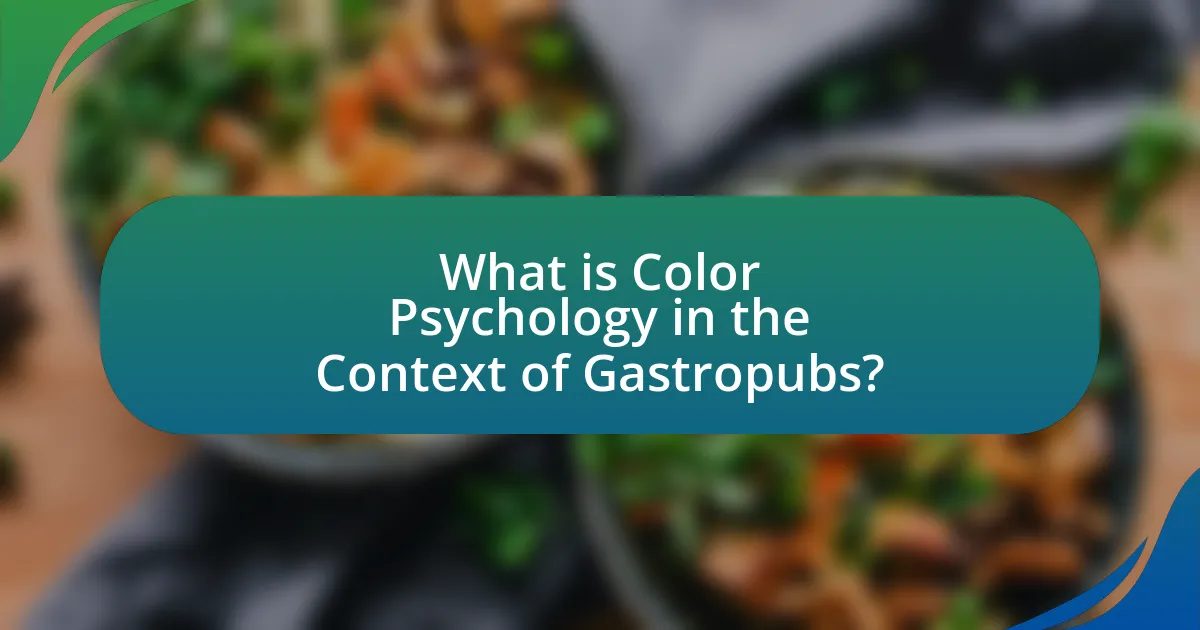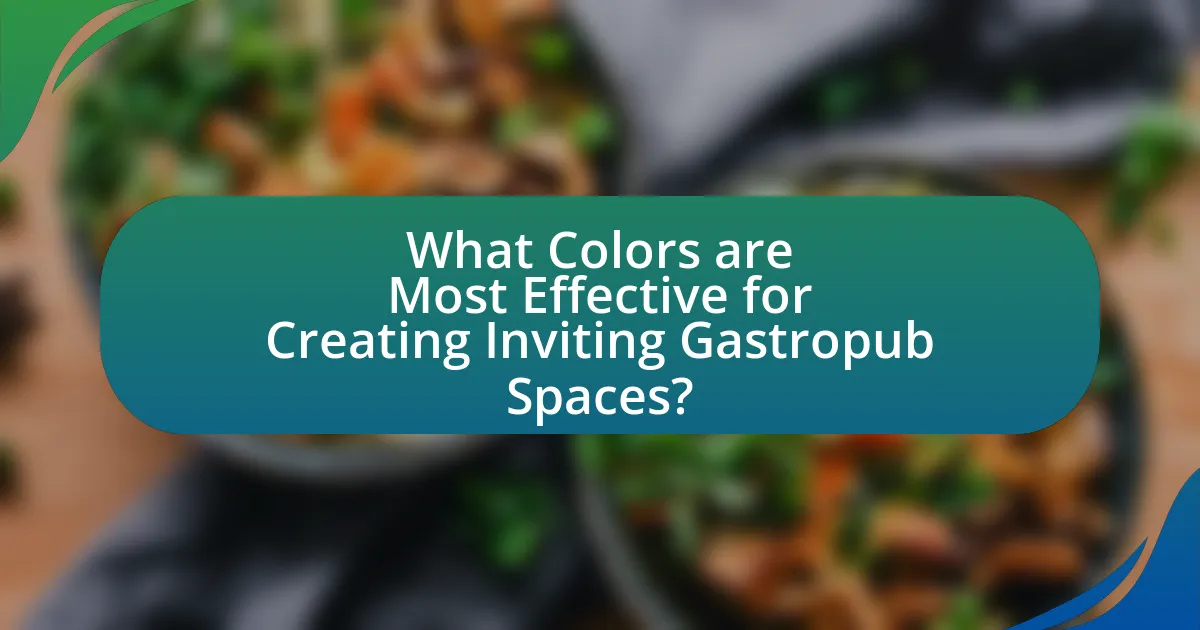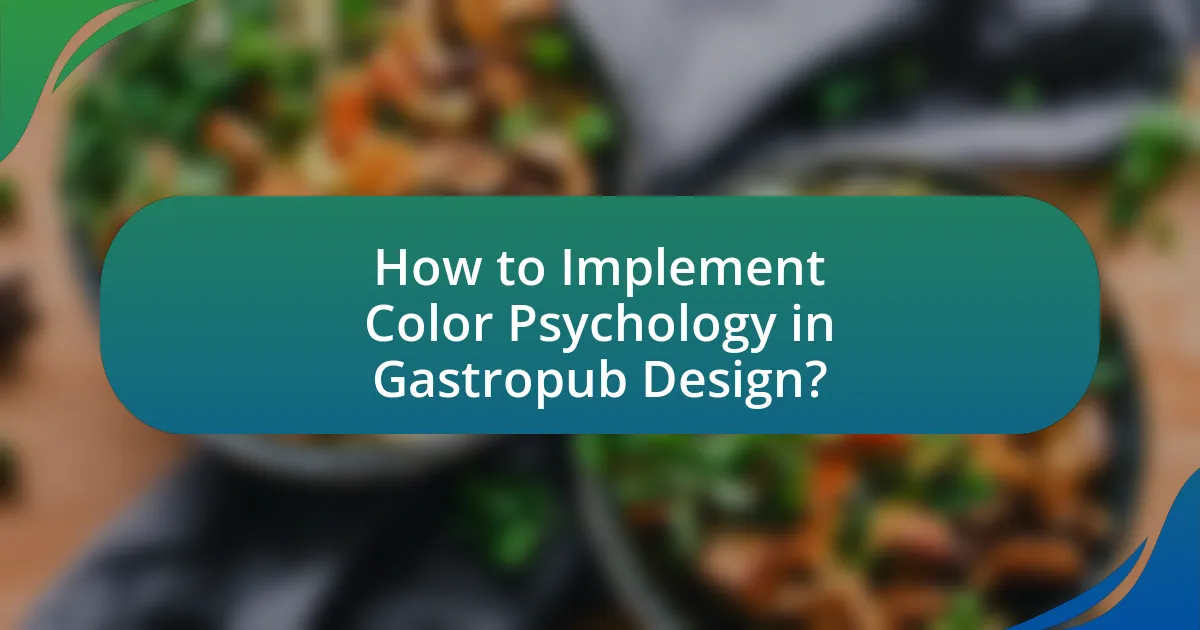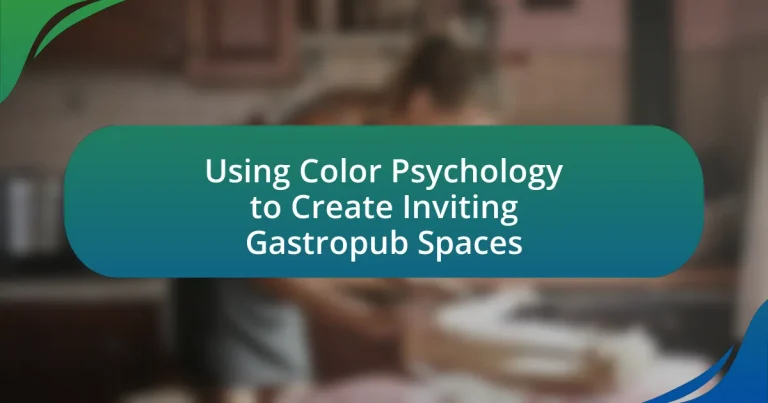The article focuses on the application of color psychology in designing inviting gastropub spaces. It explores how different colors influence customer emotions and behaviors, highlighting the importance of warm colors like red and orange in stimulating appetite and creating a lively atmosphere. The article also discusses the psychological effects of various colors, the role of ambiance in customer satisfaction, and best practices for selecting color palettes that enhance the dining experience. Additionally, it addresses the impact of lighting on color perception and offers practical tips for implementing effective color strategies in gastropub design.

What is Color Psychology in the Context of Gastropubs?
Color psychology in the context of gastropubs refers to the study of how colors influence customer emotions and behaviors within these dining spaces. Specific colors can evoke feelings of warmth, comfort, and appetite, which are essential for creating an inviting atmosphere. For instance, warm colors like red and orange can stimulate appetite and conversation, while cooler colors like blue may promote relaxation but can suppress appetite. Research indicates that the right color schemes can enhance customer experience and increase dwell time, ultimately impacting sales positively. Therefore, understanding color psychology is crucial for gastropub owners aiming to design spaces that attract and retain customers effectively.
How does color influence customer emotions and behaviors in dining spaces?
Color significantly influences customer emotions and behaviors in dining spaces by affecting mood, appetite, and overall dining experience. For instance, warm colors like red and orange can stimulate appetite and create a sense of urgency, encouraging quicker dining and increased turnover rates. In contrast, cooler colors such as blue and green tend to evoke calmness and relaxation, promoting longer stays and a more leisurely dining experience. Research by the Institute for Color Research indicates that people make a subconscious judgment about a person, environment, or product within 90 seconds of initial viewing, with color being a primary factor in that assessment. Therefore, the strategic use of color in dining spaces can enhance customer satisfaction and influence their dining choices.
What are the psychological effects of different colors on patrons?
Different colors have distinct psychological effects on patrons, influencing their emotions and behaviors. For instance, red can evoke feelings of excitement and urgency, often stimulating appetite, which is why it is commonly used in restaurants. Blue tends to create a sense of calm and trust, making it suitable for spaces where patrons seek relaxation. Yellow is associated with happiness and energy, encouraging social interaction, while green is linked to tranquility and health, promoting a refreshing atmosphere. Research by the Institute for Color Research indicates that color can increase brand recognition by up to 80%, highlighting its significant impact on consumer behavior.
How can color choices enhance the overall dining experience?
Color choices can significantly enhance the overall dining experience by influencing mood, appetite, and social interaction. For instance, warm colors like red and orange are known to stimulate appetite and create a sense of warmth and intimacy, making diners feel more comfortable and engaged. Research from the Journal of Environmental Psychology indicates that color can affect emotional responses; for example, blue tones tend to create a calming atmosphere, which can lead to longer dining durations and increased customer satisfaction. Additionally, the strategic use of color can help establish a brand identity and ambiance that resonates with the target audience, further enhancing the dining experience.
Why is creating an inviting atmosphere important for gastropubs?
Creating an inviting atmosphere is crucial for gastropubs because it enhances customer experience and encourages repeat visits. A welcoming environment fosters social interaction and relaxation, which are essential for dining establishments. Research indicates that ambiance significantly influences customer satisfaction; for instance, a study published in the Journal of Hospitality and Tourism Research found that atmospheric elements, including color and lighting, directly affect patrons’ perceptions and behaviors. Therefore, by utilizing color psychology to create a warm and inviting space, gastropubs can effectively attract and retain customers, ultimately driving sales and building a loyal clientele.
What role does ambiance play in customer satisfaction and retention?
Ambiance significantly influences customer satisfaction and retention by creating an inviting atmosphere that enhances the overall dining experience. Research indicates that elements such as lighting, color, and decor can evoke specific emotions and perceptions, directly impacting customers’ enjoyment and likelihood of returning. For instance, a study published in the Journal of Consumer Research found that warm colors and soft lighting can increase feelings of comfort and relaxation, leading to higher satisfaction levels. Additionally, a well-designed ambiance can differentiate a gastropub from competitors, fostering a unique identity that encourages repeat visits.
How can an inviting atmosphere impact a gastropub’s reputation?
An inviting atmosphere significantly enhances a gastropub’s reputation by fostering a positive customer experience. When patrons feel comfortable and welcomed, they are more likely to return and recommend the establishment to others, leading to increased foot traffic and customer loyalty. Research indicates that environments designed with warm colors and comfortable seating can elevate mood and encourage social interaction, which directly correlates with higher customer satisfaction ratings. For instance, a study published in the Journal of Environmental Psychology found that ambient factors, including color and layout, can influence diners’ perceptions of quality and service, ultimately affecting their likelihood to share positive reviews online.

What Colors are Most Effective for Creating Inviting Gastropub Spaces?
Warm colors such as deep reds, oranges, and yellows are most effective for creating inviting gastropub spaces. These colors stimulate appetite and foster a sense of warmth and comfort, making patrons feel more at ease. Research indicates that red can increase heart rates and create a sense of urgency, while orange is associated with enthusiasm and energy. Additionally, yellow is known to evoke feelings of happiness and cheerfulness. A study published in the Journal of Environmental Psychology highlights that color can significantly influence mood and behavior in dining environments, reinforcing the effectiveness of these warm tones in enhancing the overall dining experience.
Which colors are commonly used in successful gastropub designs?
Successful gastropub designs commonly utilize warm colors such as deep reds, earthy browns, and muted yellows. These colors create a cozy and inviting atmosphere, encouraging social interaction and relaxation. Research in color psychology indicates that warm tones can stimulate appetite and enhance the overall dining experience, making them effective choices for food-centric establishments. For instance, a study published in the Journal of Environmental Psychology highlights that warm colors can evoke feelings of comfort and warmth, which are essential for creating a welcoming environment in dining spaces.
What are the associations of warm colors in a dining environment?
Warm colors in a dining environment, such as reds, oranges, and yellows, are associated with increased appetite and social interaction. These colors stimulate the senses and create an inviting atmosphere, encouraging diners to engage more with their food and companions. Research indicates that warm colors can elevate mood and energy levels, making the dining experience more enjoyable. For instance, a study published in the journal “Color Research and Application” found that warm colors can enhance feelings of warmth and comfort, which are crucial in a gastropub setting where socialization is key.
How do cool colors contribute to a relaxing atmosphere?
Cool colors, such as blue, green, and violet, contribute to a relaxing atmosphere by evoking feelings of calmness and tranquility. These colors are associated with nature and water, which can lower heart rates and reduce stress levels. Research indicates that environments painted in cool colors can lead to lower blood pressure and a sense of peace, making them ideal for spaces designed for relaxation, such as gastropubs. For instance, a study published in the Journal of Environmental Psychology found that participants exposed to cool-colored environments reported significantly lower stress levels compared to those in warm-colored settings.
How can color combinations enhance the gastropub experience?
Color combinations can enhance the gastropub experience by influencing customer mood and behavior. For instance, warm colors like red and orange can stimulate appetite and create a lively atmosphere, while cooler colors like blue and green can promote relaxation and comfort. Research indicates that color psychology plays a significant role in consumer behavior; a study published in the journal “Color Research and Application” found that color can affect perceptions of taste and quality. Therefore, strategically chosen color palettes can create an inviting environment that encourages patrons to linger and enjoy their dining experience.
What are the best practices for pairing colors in interior design?
The best practices for pairing colors in interior design include using the color wheel to identify complementary colors, applying the 60-30-10 rule for balanced color distribution, and considering the psychological effects of colors on mood and atmosphere. Complementary colors, which are opposite each other on the color wheel, create vibrant contrasts that can energize a space. The 60-30-10 rule suggests using 60% of a dominant color, 30% of a secondary color, and 10% of an accent color to achieve visual harmony. Additionally, research indicates that colors like blue and green promote calmness, while warm colors like red and orange can stimulate appetite, making them effective choices for gastropub environments.
How do contrasting colors affect visual appeal and customer engagement?
Contrasting colors significantly enhance visual appeal and customer engagement by creating a dynamic and stimulating environment. When colors are used in contrast, they draw attention and highlight key elements, making them more noticeable to customers. Research indicates that high contrast can improve readability and comprehension, which is crucial in a gastropub setting where menus and signage must be easily understood. For instance, a study published in the Journal of Environmental Psychology found that contrasting colors can evoke emotional responses, leading to increased customer satisfaction and longer dwell times. This emotional engagement is vital for fostering a welcoming atmosphere that encourages patrons to return.

How to Implement Color Psychology in Gastropub Design?
To implement color psychology in gastropub design, select colors that evoke desired emotions and enhance the dining experience. For instance, warm colors like red and orange stimulate appetite and create a lively atmosphere, while cooler colors like blue and green promote relaxation and comfort. Research indicates that red can increase heart rates and encourage social interaction, making it suitable for communal dining spaces. Additionally, using earthy tones can create a welcoming environment, aligning with the gastropub’s casual and friendly vibe. By strategically applying these color principles, gastropubs can effectively influence customer mood and behavior, ultimately enhancing their overall experience.
What steps should be taken to choose the right color palette?
To choose the right color palette for a gastropub, first identify the desired atmosphere and theme, as colors evoke specific emotions and responses. Next, research color psychology to understand how different colors influence mood; for instance, warm colors like red and orange can stimulate appetite and energy, while cool colors like blue and green can create a calming effect. After that, create a color scheme that balances primary, secondary, and accent colors to ensure visual harmony. Finally, test the palette in the actual space with samples to see how lighting affects the colors, ensuring they align with the intended ambiance.
How can gastropub owners assess their target audience’s preferences?
Gastropub owners can assess their target audience’s preferences by conducting surveys and analyzing customer feedback. Surveys can be distributed both online and in-person to gather insights on menu items, ambiance, and service expectations. Additionally, analyzing customer reviews on platforms like Yelp and Google can provide valuable data on what patrons enjoy or dislike. Research indicates that 70% of consumers prefer to share their experiences through reviews, making this a reliable source of information for understanding preferences. By combining survey results with review analysis, gastropub owners can effectively tailor their offerings to meet the desires of their target audience.
What tools and resources are available for color selection?
Color selection tools and resources include color wheel applications, online color palette generators, and design software like Adobe Color and Canva. These tools allow users to explore color harmonies, create custom palettes, and visualize color combinations in various contexts. For instance, Adobe Color provides a color wheel that helps users identify complementary, analogous, and triadic color schemes, which are essential for creating inviting atmospheres in gastropub spaces. Additionally, websites like Coolors and Color Hunt offer curated color palettes that can inspire design choices based on current trends and psychological effects of colors.
How can lighting influence the perception of color in gastropubs?
Lighting significantly influences the perception of color in gastropubs by altering how colors are viewed and experienced. Different lighting conditions, such as warm or cool tones, can enhance or diminish specific colors, affecting the overall ambiance and mood of the space. For instance, warm lighting can make reds and yellows appear more vibrant, creating a cozy atmosphere, while cool lighting can make blues and greens seem more pronounced, promoting a calm environment. Studies in color psychology indicate that lighting can impact emotional responses; for example, a study published in the Journal of Environmental Psychology found that warm lighting can increase feelings of comfort and relaxation, which can enhance the dining experience in a gastropub setting.
What types of lighting work best with specific color schemes?
Warm white lighting works best with warm color schemes, such as reds, oranges, and yellows, as it enhances the inviting and cozy atmosphere these colors create. In contrast, cool white or daylight lighting complements cool color schemes, including blues and greens, by providing a refreshing and vibrant ambiance. Research indicates that warm lighting can increase feelings of comfort and relaxation, making it ideal for social spaces like gastropubs. Additionally, using accent lighting can highlight specific color features, enhancing the overall aesthetic and emotional response of the space.
How does natural light affect color perception in dining spaces?
Natural light significantly influences color perception in dining spaces by altering the way colors are seen and experienced. The spectrum of natural light, which varies throughout the day, can enhance or diminish the vibrancy of colors in a dining area. For instance, during the golden hour, warm tones become more pronounced, creating a cozy atmosphere, while midday light can make colors appear more neutral or washed out. Research indicates that natural light can affect mood and appetite; a study published in the Journal of Environmental Psychology found that exposure to natural light can enhance feelings of well-being and increase the likelihood of social interaction, which is crucial in dining environments. Thus, the interplay between natural light and color perception plays a vital role in shaping the ambiance and overall dining experience.
What are some practical tips for applying color psychology in gastropubs?
To effectively apply color psychology in gastropubs, utilize warm colors like red and orange to stimulate appetite and create a lively atmosphere. Research indicates that red can increase heart rates and encourage social interaction, making it ideal for communal dining spaces. Incorporate earthy tones such as browns and greens to evoke a sense of comfort and connection to nature, which can enhance the dining experience. Additionally, use blue sparingly, as it is known to suppress appetite; however, it can be effective in creating a calming environment in lounge areas. Implementing these color strategies can significantly influence customer mood and behavior, ultimately enhancing their overall experience in the gastropub.
How can gastropub owners test color choices before full implementation?
Gastropub owners can test color choices before full implementation by utilizing sample boards or swatches in their spaces. This method allows them to observe how different colors interact with lighting and decor throughout various times of the day. Additionally, conducting focus groups with patrons can provide valuable feedback on color preferences and emotional responses, as studies show that color can significantly influence mood and behavior in dining environments. For instance, research indicates that warm colors can stimulate appetite, while cool colors may create a calming effect. By combining visual testing and patron feedback, gastropub owners can make informed decisions that enhance the overall ambiance and appeal of their establishments.
What common mistakes should be avoided when using color in design?
Common mistakes to avoid when using color in design include poor color contrast, overuse of bright colors, neglecting color harmony, and ignoring cultural associations. Poor color contrast can lead to readability issues, making text difficult to read against a background. Overusing bright colors can overwhelm viewers and create a chaotic visual experience. Neglecting color harmony can result in a disjointed design that lacks cohesion, while ignoring cultural associations can alienate specific audiences, as colors can have different meanings in various cultures. For instance, red may evoke excitement in some cultures but signify danger in others.




